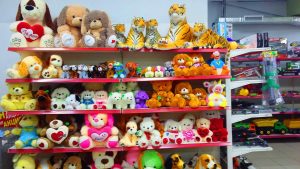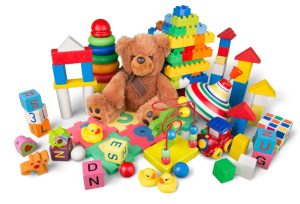Baby toys are specially designed toys that are safe and appropriate for infants and young children to play with. They are typically made of soft, non-toxic materials and are designed to be easy for babies to grasp and manipulate.
Types of baby toys
Some common types of baby toys include:
- Soft toys: These are usually made of plush fabric or other soft materials, and can be cuddled, squeezed, and played with.
- Rattles: These toys make noise when shaken, and can help babies develop their motor skills and hand-eye coordination.
- Teething toys: These toys are designed to be chewed on, which can help soothe babies’ sore gums as their teeth come in.
- Activity mats: These are play mats that have various toys, textures, and colors attached to them, and can help stimulate babies’ senses and promote tummy time.
- Musical toys: These toys play music or make other sounds, and can be entertaining for babies as well as help develop their auditory skills.
When choosing baby toys, it’s important to make sure they are age-appropriate, safe, and free of any choking hazards. Always follow the manufacturer’s guidelines and recommendations for age and use.
Soft toys:
Soft toys are toys that are made from plush fabric or other soft materials, such as cotton, polyester, or fleece. They are often designed to look like animals or other cute characters, and are popular with young children and infants.
Soft toys are typically safe for babies and young children to play with, as they are made from non-toxic materials and are designed to be gentle on a child’s delicate skin. They can provide comfort, security, and companionship to children, and are often used as a source of comfort and as a transitional object when children are separating from their caregivers.
Soft toys can also help to promote imaginative play and creativity in children, as they encourage children to use their imaginations to create stories and adventures with their toys. They can also provide sensory stimulation, as children can explore the different textures and materials of the toys.
When selecting soft toys for children, it’s important to choose toys that are age-appropriate and safe. Look for toys that are labeled as machine washable, as this will make it easier to keep them clean and hygienic. It’s also important to avoid toys with small parts or loose threads that could be a choking hazard for young children.

Rattles:
Rattles are toys that make noise when shaken, and are often used for infants and young children. They can come in a variety of shapes and sizes, but they generally consist of a hollow container with a small object inside, such as beads or small balls, that makes a sound when the container is shaken.
Rattles can be beneficial for young children in several ways. They can help to develop a baby’s hand-eye coordination and fine motor skills, https://takizo.shop as they encourage children to reach for and grasp the toy. Rattles can also provide sensory stimulation, as the sound and movement of the toy can help to engage a child’s senses and promote their cognitive development.
When selecting rattles for children, it’s important to choose toys that are age-appropriate and safe. Look for rattles that are made from non-toxic materials and do not have any small parts or loose pieces that could be a choking hazard for young children. Additionally, it’s important to monitor children while they are playing with rattles to ensure that they are using them safely and appropriately.
Teething toys:
Teething toys are toys that are specifically designed to help soothe a baby’s gums and teeth during the teething process. Teething can be a painful and uncomfortable experience for babies, and teething toys can provide relief by allowing them to chew and gnaw on a safe and appropriate object.
Teething toys can come in a variety of shapes and sizes, but they are typically made from soft, non-toxic materials that are safe for babies to put in their mouths. Some common materials used to make teething toys include silicone, rubber, and fabric. Some teething toys may also have different textures or ridges to provide additional relief for sore gums.
When selecting teething toys for children, it’s important to choose toys that are age-appropriate and safe. Look for teething toys that are labeled as BPA-free and have been tested for safety. Avoid toys with small parts or loose pieces that could be a choking hazard for young children. It’s also important to clean teething toys regularly to prevent the buildup of bacteria and germs.
Teething toys can be a helpful tool for parents to provide comfort and relief for their babies during the teething process. However, it’s important to monitor children while they are using teething toys to ensure that they are using them safely and appropriately.
Activity mats:
Educational mats for children are play mats that are designed to promote learning and development in young children. These mats can come in a variety of sizes and styles, but they generally feature colorful graphics, letters, numbers, shapes, and other educational elements that are meant to engage children and encourage their cognitive development.
Some common types of educational mats for children include:
- Alphabet mats: These mats feature the letters of the alphabet and can help children learn to recognize and identify letters.
- Number mats: These mats feature numbers and can help children learn to count and recognize numbers.
- Shape mats: These mats feature different shapes and can help children learn to identify and recognize shapes.
- Play mats with roads and buildings: These mats feature roads, buildings, and other elements that can be used for imaginative play and can help children develop their creativity and social skills.
Educational mats for children can be a helpful tool for parents and caregivers to promote learning and development in young children. However, it’s important to choose mats that are age-appropriate and safe for children to use. Look for mats that are made from non-toxic materials and are easy to clean. Additionally, it’s important to supervise children while they are using educational mats to ensure that they are using them safely and appropriately.
Musical toys:
Musical toys for children are toys that produce sound or music, and are often used to encourage creativity, stimulate sensory development, and promote a love for music. These toys can come in a variety of shapes and sizes, from small handheld instruments to larger electronic keyboards and guitars.
Some common types of musical toys for children include:
- Percussion instruments: These include items such as drums, tambourines, and maracas, and can help children develop rhythm and coordination.
- Electronic keyboards and pianos: These toys can help children develop an appreciation for music and can teach them basic musical concepts such as melody and harmony.
- Toy guitars and ukuleles: These toys can help children develop fine motor skills and hand-eye coordination, and can also encourage creativity and self-expression.
- Singing toys: These toys may include plush animals or dolls that sing, and can help children learn songs and develop language skills.
Musical toys for children can be a fun and engaging way to introduce children to music and promote their development. However, it’s important to choose toys that are age-appropriate and safe for children to use. Look for toys that are made from non-toxic materials and are easy to clean. Additionally, it’s important to supervise children while they are using musical toys to ensure that they are using them safely and appropriately.
How to choose the right toys for children?
Choosing the right toys for children can be an important decision that can affect their development and wellbeing. Here are some factors to consider when choosing toys for children:
- Age-appropriateness: It’s important to choose toys that are appropriate for a child’s age and developmental stage. Toys that are too advanced or too simple can be frustrating or boring for children, and may not promote their development effectively.
- Safety: Look for toys that are made from non-toxic materials and have been tested for safety. Avoid toys with small parts or sharp edges that could be a choking or injury hazard for young children.
- Educational value: Consider toys that promote learning and development in areas such as language, cognitive, social, and physical development. Look for toys that encourage creativity, problem-solving, and imagination.
- Interest and engagement: Choose toys that align with a child’s interests and abilities. Children are more likely to engage with toys that interest them and are enjoyable to play with.
- Durability: Consider the durability and quality of the toy. Toys that are made to last can provide more value over time and can be passed down to younger siblings or friends.
- Cost: Consider the cost of the toy and whether it provides value for money. Expensive toys may not necessarily be better than more affordable ones.
In summary, when choosing toys for children, it’s important to consider age-appropriateness, safety, educational value, interest and engagement, durability, and cost. By taking these factors into account, parents and caregivers can select toys that are not only fun and entertaining but also promote their children’s development and wellbeing.
What toys will benefit children?
There are many toys that can benefit children and promote their development in different areas. Here are some examples:
- Building blocks and construction toys: These toys can promote problem-solving, creativity, and fine motor skills.
- Puzzles: Puzzles can promote cognitive development, problem-solving, and hand-eye coordination.
- Art supplies: Art supplies like crayons, paints, and markers can encourage creativity, imagination, and fine motor skills.
- Musical toys: Musical toys can promote an appreciation for music, rhythm, and coordination.
- Board games: Board games can promote social skills, cognitive development, and problem-solving.
- Outdoor toys: Outdoor toys like balls, bikes, and playground equipment can promote physical activity, coordination, and social skills.
- Books: Reading and storytelling can promote language development, cognitive development, and imagination.
- Role-play toys: Role-play toys like dolls, toy kitchens, and dress-up clothes can promote creativity, social skills, and language development.
It’s important to note that not all children will benefit from the same toys in the same way. Children have different interests, abilities, and learning styles, so it’s important to choose toys that are appropriate and engaging for each individual child. By providing children with a variety of toys that are developmentally appropriate and align with their interests and abilities, parents and caregivers can help promote their children’s overall development and wellbeing.
